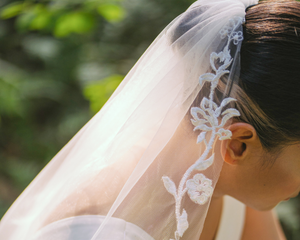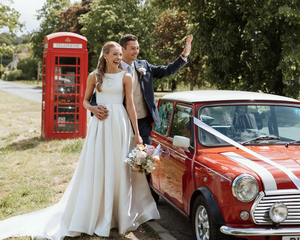You may also like
Luxury vs affordable veils is a choice about materials, craftsmanship, and the role your veil will play. Luxury pieces use premium fabrics and hand-finished details that carry time and cost. Affordable styles use smart materials and simple finishes that keep the silhouette clean and the budget steady. Both can look beautiful in person and in photos when matched to the dress and the day.
This article helps you decide what is worth paying for based on fabric, construction, styling, and longevity. It offers practical checkpoints and shows how to choose a veil that suits your dress, plans, and priorities.
The Definition of a Luxury Veil
A luxury veil is built on three pillars: superior materials, hand work, and tailored design. Each element affects drape, light, movement, and how the veil sits with your gown.

OCEAN | Luxury ocean-inspired wedding veil with 3D embroidered marine life featuring jellyfish, starfish, seahorses, and seaweed on organza fabric, perfect for beach weddings
Fabrics that set the standard
Silk tulle is considered the crown of bridal fabrics. Its softness against the skin, fluid movement, and luminous finish create a veil that feels alive in photographs and under natural light. English net is another sought-after choice, offering a slightly firmer fall and a matte texture that works well with structured dresses. Other refined options include Swiss tulle, valued for its strength and balance, and point d’esprit, with its subtle dotted weave that adds character without distraction. The distinction lies in fibre purity and the way the fabric holds both shape and drape.

GLORIOSA | Cathedral length wedding veil with 3D gloriosa flowers and embroidered peonies, handcrafted for depth and dimension, with tulle and organza fabric
Lace and hand finishing
True luxury is visible in the lacework. Chantilly lace delivers delicate patterning, while Alençon lace adds definition with raised cord details. In high-end veils, motifs are hand-cut and placed so that patterns align seamlessly at the edges and hem. Beads, pearls, and crystals are stitched one by one, with weight carefully distributed to ensure natural movement. Even the edges signal craftsmanship. A rolled hem or hand-applied trim avoids the stiffness that machine finishes often leave behind.

TARA Bridal's artisan hand-embroidering 3D beaded ocean-inspired wedding veil
Structure and balance
A luxury veil is made to sit properly from the moment it is placed. The gathers at the comb are even, the layers fall without creasing, and the blusher lifts smoothly without losing shape. Symmetry is deliberate: motifs mirror across the centre, and lines fall exactly where the eye expects them. Fine thread matched to the base fabric keeps stitching invisible, ensuring every seam disappears into the tulle.

Our Bride: Anna Dietrich, MI USA. Veil: Rebecca - Royal Cathedral 130”. Photo: Lydia Charles
Comfort in wear
Attachment is another hallmark. High-quality veils use wrapped metal combs or hand-bound mounts that secure firmly while remaining comfortable for hours of wear. The construction distributes weight evenly so the veil stays flat against the crown rather than pulling or tilting as you move through the day.
Design in proportion
Luxury veils are cut with the gown in mind. Cathedral, chapel, and royal lengths are measured to align with the dress hem, while mantilla or oval cuts are shaped to frame the shoulders and face with precision. Every line is intentional, ensuring that the veil adds presence without competing with the gown.
Colour and custom detail
Ivory is never one shade. Luxury makers match tone exactly to the gown, adjusting warmth or coolness so fabric and dress appear seamless. Brides can also request personal details such as initials embroidered at the hem, lace from a family heirloom integrated into the border, or a custom length that fits the ceremony setting.
Longevity and heirloom quality
A luxury veil is designed to endure. With proper care such as acid-free tissue, a pH-neutral storage box, and occasional professional cleaning, silk and lace retain their beauty for decades. Many brides choose luxury specifically for this reason: the ability to preserve the veil as a family keepsake.
What Makes an Affordable Veil Stand Out?
Affordable veils may not carry the same labour-intensive details as couture designs, but they hold their own in style, comfort, and practicality. Four qualities define why affordable veils continue to appeal.
Modern fabrics that perform well
Illusion tulle made from nylon or polyester is the standard for affordable veils. It is light, sheer, and strong enough to resist tearing, which makes it reliable for a full day of wear. Though it lacks the natural softness of silk, it photographs with the same floating effect and holds shape better in movement and wind.

Our Bride: Gretchen Stern - California, USA - Veil: 3D Kayla - Photo: Julieta
Finishes that create impact without cost
Most affordable veils rely on clean-cut edges, stitched hems, or machine-made lace. These finishes may be simpler, but when paired with an ornate gown they allow the dress to take focus. Subtle embroidery or scattered pearls are often used sparingly, giving a touch of detail without adding weight or expense.

Easy access and quick availability
Ready-to-wear veils are stocked widely, both in bridal boutiques and online. Brides working to shorter timelines often favour these options as they can be tried on immediately or ordered with little waiting time. Online retailers also provide assurance through customer reviews and shared photographs, which helps with decision-making.
Value in flexibility
Affordable veils are practical for brides who want a statement piece for the ceremony but prefer to remove it before the reception. Lower cost means less concern about wear, travel, or storage. Many mid-range designers now offer affordable veils with thoughtful construction, giving brides durability and elegance at a price that stays within reach.
The Crucial Elements of Veil Comparison
Dress Compatibility
The dress and veil should work together, not compete for attention. A gown with detailed embroidery, beadwork, or heavy lace often benefits from a simple veil that frames the dress without adding more weight to the look. In contrast, a clean, modern gown can carry a dramatic cathedral veil with lace borders or soft embellishments, giving depth and romance to a minimalist silhouette.
Necklines, sleeves, and back details also matter. A high neckline or illusion bodice pairs best with sheer or lightly edged veils, while strapless gowns allow room for bold lace or layered designs. Movement is another factor to check during fittings. Walking, sitting, and turning will reveal if the veil complements the gown’s proportions or interrupts its lines.
Photographic Impact
Fabric type changes how a veil photographs. Silk tulle softens light and creates a luminous glow in outdoor shots, while illusion tulle holds sharper lines and shows more structure in still photography. Matte nets reduce reflection under studio lighting, making them useful for indoor portraits, whereas glossy finishes can create unwanted glare in flash photography.
Edges and embellishments also alter the image. A plain cut edge disappears on camera, keeping focus on the gown and bride, while a lace hem or beaded scatter frames the face and shoulders. Denser lace or heavy beading can darken sections of the veil when backlit, so spacing motifs evenly ensures the veil remains balanced in photographs from all angles.
Comfort and Wearability
Comfort is one of the most overlooked considerations. A veil should stay in place without causing tension at the crown or shifting as the bride moves. Wrapped metal combs are more secure than plastic alternatives and distribute weight evenly across hairstyles. Brides wearing layered or cathedral veils should check that the gathering is smooth, so the veil falls naturally rather than pulling in one direction.
The drape of the material also affects movement. Lightweight nylon tulle is easy to wear during a long ceremony and resists tearing, while heavier silk requires careful handling but offers an unmatched softness against the skin. Practical checks include sitting in the veil, walking outdoors, and practising how it lifts for photographs or during the reception. Brides who plan to dance or change outfits later may prefer a design that can be pinned or removed easily without disturbing the hairstyle.
Longevity and Budget Priorities
Durability is strongly linked to fabric and finish. Silk tulle and hand-applied lace, when stored in acid-free tissue and a pH-neutral box, can last for decades and become heirlooms. Nylon and polyester veils are robust for the day itself and resist snags, but they may yellow more quickly and are harder to preserve in perfect condition. Brides who want to keep their veil for future generations often lean toward luxury options with stitched trims and replaceable combs.
Budget is the deciding factor for many brides. A veil does not need to equal the cost of the gown, but allocating a percentage of the overall attire budget helps keep spending realistic. Affordable veils often suit brides who plan to wear them only for the ceremony, while luxury veils justify their cost through longevity and unique design.
However, mid-range options strike a balance, offering semi-custom features such as length and edging choices that give individuality without the higher price tag. Brides should always compare the cost to the value it brings to their day, their photographs, and their long-term plans for the veil.
Get to know about: Custom vs Ready-Made Veils: Pros, Cons & Which to Buy
Questions to Ask Yourself Before Deciding
Is fabric feel and drape important to me? Silk tulle is soft, fluid, and weightless, while nylon or polyester tulle feels firmer and holds shape more clearly. If touch and flow matter to you, luxury fabrics are worth the spend. If you care more about look than feel, modern synthetics perform well in photos.
Do I want artisan detail or unique design? Hand-cut lace, embroidery, or beading takes hours of skilled work and makes each veil one of a kind. Mass-produced pieces use machine stitching and repeated motifs. Brides seeking individuality and craftsmanship lean towards luxury. Those happy with classic shapes and subtle trims find value in affordable designs.
Will my veil become a keepsake or heirloom? Durable fabrics and hand-applied finishes can be preserved for decades. A luxury veil can be cleaned, stored, and passed down. Affordable veils often serve beautifully on the day but may not keep their condition long term. If sentiment and future use are priorities, heirloom-quality materials are essential.
Does my dress need balance or drama? A detailed gown usually pairs best with a clean, simple veil. Minimal gowns leave room for statement pieces such as cathedral lengths or lace borders. Think about proportion: the veil should support the overall look, not compete with it.
Will I wear it just for the ceremony or all day? If you plan to remove the veil after vows, an affordable option may be sensible. If you want it present for portraits, reception entrances, or the first dance, comfort and durability become more important. Luxury veils are designed to sit securely for long wear without pulling.
Am I prioritising style, sentiment, or budget? Your priorities shape the decision. Style-driven brides may choose the design that best completes their gown. Sentimental brides often invest in an heirloom piece. Budget-focused brides select an elegant but accessible veil that frees resources for other parts of the wedding. Each approach is valid, but being clear helps avoid regret.
Find The Amazing Collections at Tara Bridal Now!
At Tara Bridal, you get handcrafted veils with real substance, fast support, and global delivery. Rush orders are available, and standard worldwide shipping is free above $350, so you can order with confidence and clear timelines.
Shop at Tara Bridal today and secure the veil that completes your day.








